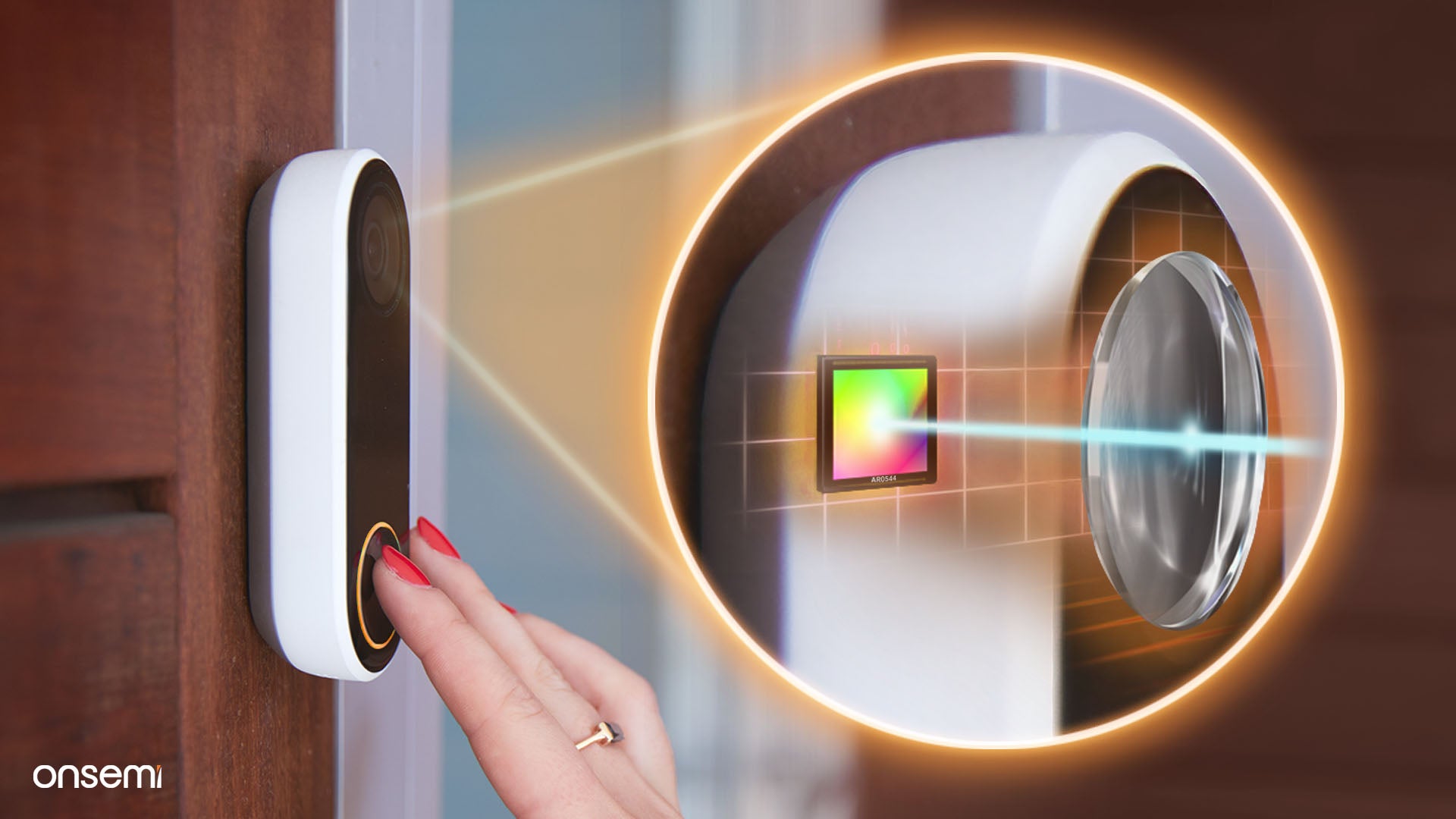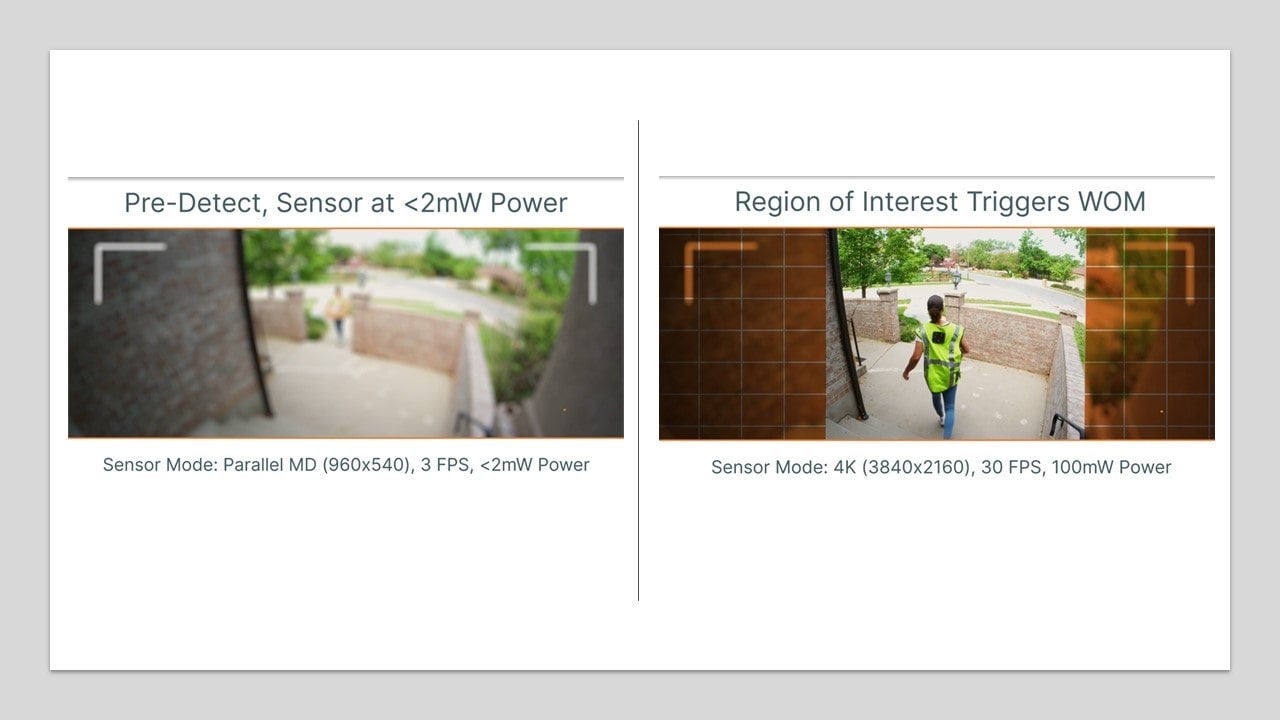Have you ever wondered how a smart doorbell detects when a person is walking up to your front doorstep or how it can identify important camera movements? The answer is image sensors. These tiny sensors that are built into the doorbell can clearly display the images of who or what is exactly approaching your doorstep. They operate in full state (full resolution, 30fps) all the time. Considering that these devices need to operate 24/7, you might wonder how long the popular battery-operated versions (as an example) can operate reliably.
onsemi’s newest image sensor family, HyperluxTM LP, has a built-in feature known as Wake on Motion (WoM) that enables the sensors to operate in a low-power mode that draws a fraction of the power needed in the full-performance mode. Once the sensor detects movement, it moves to a higher performance state in less time than it takes to snap a photo. In this blog, we dive deeper into the Wake on Motion feature, its benefits, and the various scenarios it can be used.
Benefits of WOM
The WoM feature in an image sensor enables a vision system to operate based on object movements in the scene. When the sensor operates in WoM mode, it stays in a pre-detect state (low resolution, low frame rate). When motion is detected, the image sensor determines if there is indeed a motion in the scene and sends a notification to the image signal processor (ISP) / system-on-chip (SoC). The latter then determines if the motion is indeed true for the application upon which it wakes up the entire vision system for the intended operation. This feature is a considerable benefit as most applications do not need their vision systems to operate in Native mode (full resolution, max frame rate) all the time. This state typically is needed for only a fraction of the operational time, and for the rest of the duration, the sensor can be in the pre-detect state where the power consumed is at the lowest level.
In the pre-detect state, Hyperlux LP image sensors consume less than 1/100th of the power consumed in the native mode. The WoM feature brings a tremendous impact to power savings and longevity of operational cycle of vision systems that are sensitive to power consumed. The ability to operate at the lowest power levels both in the case of limited power sources like batteries or continuous supply. In the former case, it enables extending the charging cycles significantly and, in the latter, providing differentiated systems with innovative features operating at the edge instead of distance central processing systems.
Applications Using WOM
Vision systems used in access controls (video doorbells, biometric access), public security and safety (bodycams), and security (surveillance cameras) can all leverage the WoM feature. For example, video doorbells are either battery-power sourced or wall-power sourced at very low power deliveries (< 20W @ power factor of 1). In the former case, industry trends demand charging cycles of 180 days presently & targeting a full year. The lack of a feature like WOM would force the system to process full resolution all the time at the chosen frame rate, regardless of whether there is pertinent motion in the scene or not. And most often, this is relevant only when a human walks to the door. Being able to move the video doorbell to the pre-detect state keeps the system operational at the lowest power consumption state, yet by virtue of the WoM mode, moving into normal operation on demand.
Applications like surveillance cameras that are not battery-powered also benefit significantly from the WoM feature. The dominant operational condition of the pre-detect state in WoM mode minimizes the bandwidth generated significantly without loss of the scene for context. This, in turn, reduces storage and thermal management requirements and consequently the total cost of ownership of the vision system.
While the base form of the WOM feature as described above is very helpful, an extended need is how can we make this more targeted with the motion. For example, we certainly don’t want the image sensor and consequentially the vision system to wake up because of wind blowing the leaves in a tree or a bird flying past in the scene. It would be highly valuable to keep the sensor targeted to region(s) of interest (ROI).
onsemi’s Hyperlux LP family of image sensors is built with the WoM feature with the capability to tailor this feature to desired ROIs non-contiguously. Architected & designed for ultra-low power consumption, this additional feature enhances the capabilities of vision systems tremendously in their applications.
Contact sales for more information about the Hyperlux LP family.
Author Bio
Ganesh Narayanaswamy, Product Line Management, onsemi
Ganesh Narayanaswamy is responsible for the image sensors product line & business management in the Industrial & Commercial Sensing Division (ICSD) at onsemi. He focuses on bringing vision solutions to the commercial & industrial markets, and business growth in multiple geographical regions. Ganesh joined onsemi from Xilinx where he managed the Industrial Vision and Electric Drives businesses globally. Prior to that, he managed the Networking ASICs business at Avago and at ST Microelectronics, led the product marketing efforts for Structured ASICs at Altera, and designed/developed multiple devices at National Semiconductor. Ganesh holds an MBA from Santa Clara University and a MS(EE) from Mississippi State
Additional Resources
Low Power Image Sensors Revolutionize Vision System Design and Efficiency



